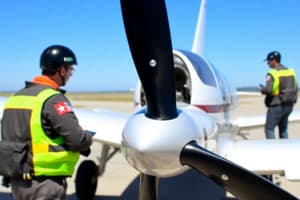Podcast
Questions and Answers
What type of advisories are AIRMETs primarily intended for?
What type of advisories are AIRMETs primarily intended for?
- All types of air traffic control issues
- Severe thunderstorms and their effects
- Aircraft with less capability or performance (correct)
- Emergency situations requiring immediate action
How often are AIRMETs typically issued?
How often are AIRMETs typically issued?
- Every six hours (correct)
- Every day
- Every twelve hours
- Every hour
Which of the following conditions would NOT trigger a SIGMET?
Which of the following conditions would NOT trigger a SIGMET?
- Volcanic ash affecting flight operations
- Dust storms with visibility below three miles
- Severe icing not associated with thunderstorms
- Severe turbulence caused by thunderstorms (correct)
What is the validity period for a SIGMET?
What is the validity period for a SIGMET?
What type of weather phenomena do Convective SIGMETs specifically address?
What type of weather phenomena do Convective SIGMETs specifically address?
Which statement about AIRMETs is incorrect?
Which statement about AIRMETs is incorrect?
What is a key difference between AIRMETs and SIGMETs?
What is a key difference between AIRMETs and SIGMETs?
Which advisory would you issue for severe clear air turbulence (CAT)?
Which advisory would you issue for severe clear air turbulence (CAT)?
What does an AIRMET regarding extensive mountain obscuration signify?
What does an AIRMET regarding extensive mountain obscuration signify?
What is one of the impacts of Convective SIGMETs?
What is one of the impacts of Convective SIGMETs?
AIRMETs are primarily concerned with weather that poses a danger to all aircraft types.
AIRMETs are primarily concerned with weather that poses a danger to all aircraft types.
SIGMETs are issued every four hours and are scheduled advisories.
SIGMETs are issued every four hours and are scheduled advisories.
Convective SIGMETs focus on weather phenomena associated with thunderstorms.
Convective SIGMETs focus on weather phenomena associated with thunderstorms.
Severe icing associated with thunderstorms is reported in AIRMET advisories.
Severe icing associated with thunderstorms is reported in AIRMET advisories.
AIRMETs are issued to inform pilots about limited visibility due to severe dust storms.
AIRMETs are issued to inform pilots about limited visibility due to severe dust storms.
Widespread IFR conditions can be covered by AIRMETs.
Widespread IFR conditions can be covered by AIRMETs.
Moderate turbulence is considered a condition that would trigger a SIGMET.
Moderate turbulence is considered a condition that would trigger a SIGMET.
Volcanic ash is a type of condition reported by AIRMETs.
Volcanic ash is a type of condition reported by AIRMETs.
The validity of AIRMETs is longer than that of SIGMETs.
The validity of AIRMETs is longer than that of SIGMETs.
AIRMETs cover only non-convective weather phenomena.
AIRMETs cover only non-convective weather phenomena.
What significant adjustments might pilots need to make due to Convective SIGMETs?
What significant adjustments might pilots need to make due to Convective SIGMETs?
How does the presence of AIRMETs affect pilots' decision-making?
How does the presence of AIRMETs affect pilots' decision-making?
Describe the implications of embedded thunderstorms as reported in Convective SIGMETs.
Describe the implications of embedded thunderstorms as reported in Convective SIGMETs.
What is the typical validity period for a Convective SIGMET?
What is the typical validity period for a Convective SIGMET?
In what way are SIGMETs and Convective SIGMETs different from AIRMETs?
In what way are SIGMETs and Convective SIGMETs different from AIRMETs?
Why is it important for pilots to interpret Convective SIGMETs accurately?
Why is it important for pilots to interpret Convective SIGMETs accurately?
What conditions do Convective SIGMETs specifically warn pilots about regarding thunderstorm activity?
What conditions do Convective SIGMETs specifically warn pilots about regarding thunderstorm activity?
What impact do SIGMETs have on flight planning for pilots?
What impact do SIGMETs have on flight planning for pilots?
How often are Convective SIGMETs issued, and why is this frequency important?
How often are Convective SIGMETs issued, and why is this frequency important?
What is a common consideration for pilots when assessing AIRMETs?
What is a common consideration for pilots when assessing AIRMETs?
Flashcards are hidden until you start studying
Study Notes
AIRMETs
- AIRMET stands for Airmen's Meteorological Information, issued by the National Weather Service.
- AIRMETs inform pilots of less severe weather conditions significant for aircraft operations.
- Issued every six hours or as needed, AIRMETs cover less severe weather impacting smaller aircraft or those with lower performance capabilities.
- Three types of AIRMETs:
- AIRMET Sierra: Addresses IFR conditions and major mountain obscuration.
- AIRMET Tango: Covers moderate turbulence, sustained surface winds of 30 knots or greater, and non-convective low-level wind shear.
- AIRMET Zulu: Highlights moderate icing conditions and outlines freezing level heights.
- AIRMET information includes type, location, altitude range, and expected conditions.
- Crucial for pre-flight planning and in-flight decision-making, impacting visibility, winds, and overall flight safety.
SIGMETs
- SIGMET stands for Significant Meteorological Information, alerting pilots to severe weather threats applicable to all aircraft types.
- SIGMETs cover a broader range of severe weather phenomena compared to AIRMETs.
- Common conditions addressed by SIGMETs include:
- Non-convective severe turbulence.
- Severe or extreme icing.
- Dust storms and volcanic ash affecting visibility and aircraft safety.
- SIGMETs are unscheduled and valid for four hours, possibly reissued if conditions persist longer.
- Essential for pre-flight planning and in-flight adjustments, ensuring pilots can respond to rapidly changing severe weather.
Convective SIGMETs
- Convective SIGMETs are a specific type of SIGMET focused on convective weather phenomena.
- Indicate severe turbulence, severe icing, and low-level wind shear associated with thunderstorms.
- Important for all aircraft, highlighting the potential hazards posed by severe thunderstorms.
Importance of Weather Advisories
- Understanding AIRMETs, SIGMETs, and Convective SIGMETs is critical for flight safety.
- Effective monitoring and analysis of these advisories enhance risk management during flights.
- Ignoring these advisories can have serious legal and safety implications for flight operations.
- Adapting flight plans based on weather advisories ensures the safety and efficiency of aviation operations.
Practical Integration
- Review all relevant AIRMETs and SIGMETs during pre-flight planning.
- Continuously monitor updates while in-flight to make informed decisions regarding routes and altitudes.
- Awareness of weather advisories supports pilots in making timely adjustments to ensure passenger comfort and safety.
Upcoming Learning
- Further discussion will focus on Aircraft Performance and Weather, emphasizing how weather advisories affect flight safety and aircraft performance.
AIRMETs
- AIRMET stands for Airmen's Meteorological Information, issued by the National Weather Service.
- AIRMETs inform pilots of less severe weather conditions significant for aircraft operations.
- Issued every six hours or as needed, AIRMETs cover less severe weather impacting smaller aircraft or those with lower performance capabilities.
- Three types of AIRMETs:
- AIRMET Sierra: Addresses IFR conditions and major mountain obscuration.
- AIRMET Tango: Covers moderate turbulence, sustained surface winds of 30 knots or greater, and non-convective low-level wind shear.
- AIRMET Zulu: Highlights moderate icing conditions and outlines freezing level heights.
- AIRMET information includes type, location, altitude range, and expected conditions.
- Crucial for pre-flight planning and in-flight decision-making, impacting visibility, winds, and overall flight safety.
SIGMETs
- SIGMET stands for Significant Meteorological Information, alerting pilots to severe weather threats applicable to all aircraft types.
- SIGMETs cover a broader range of severe weather phenomena compared to AIRMETs.
- Common conditions addressed by SIGMETs include:
- Non-convective severe turbulence.
- Severe or extreme icing.
- Dust storms and volcanic ash affecting visibility and aircraft safety.
- SIGMETs are unscheduled and valid for four hours, possibly reissued if conditions persist longer.
- Essential for pre-flight planning and in-flight adjustments, ensuring pilots can respond to rapidly changing severe weather.
Convective SIGMETs
- Convective SIGMETs are a specific type of SIGMET focused on convective weather phenomena.
- Indicate severe turbulence, severe icing, and low-level wind shear associated with thunderstorms.
- Important for all aircraft, highlighting the potential hazards posed by severe thunderstorms.
Importance of Weather Advisories
- Understanding AIRMETs, SIGMETs, and Convective SIGMETs is critical for flight safety.
- Effective monitoring and analysis of these advisories enhance risk management during flights.
- Ignoring these advisories can have serious legal and safety implications for flight operations.
- Adapting flight plans based on weather advisories ensures the safety and efficiency of aviation operations.
Practical Integration
- Review all relevant AIRMETs and SIGMETs during pre-flight planning.
- Continuously monitor updates while in-flight to make informed decisions regarding routes and altitudes.
- Awareness of weather advisories supports pilots in making timely adjustments to ensure passenger comfort and safety.
Upcoming Learning
- Further discussion will focus on Aircraft Performance and Weather, emphasizing how weather advisories affect flight safety and aircraft performance.
AIRMETs Overview
- AIRMET: Airmen's Meteorological Information, a non-severe weather advisory for pilots.
- Issued by the National Weather Service for conditions not intense enough to qualify as SIGMETs.
- Typically refreshed every six hours or as needed, targeting mostly light aircraft.
Types of AIRMETs
- AIRMET Sierra: Covers IFR conditions and mountain obscuration.
- AIRMET Tango: Alerts to moderate turbulence, winds of 30 knots or more, and low-level wind shear.
- AIRMET Zulu: Focuses on moderate icing and indicates freezing level heights.
Importance of AIRMETs
- Alerts pilots to weather changes affecting visibility and safety.
- Essential for thorough pre-flight planning and in-flight decision-making.
- Ignoring AIRMETs can lead to legal and safety repercussions for flight operations.
Integrating AIRMETs into Flight Planning
- Review relevant AIRMETs during pre-flight and monitor updates in-flight.
- Be prepared to adjust course or altitude based on AIRMET advisories for safety.
SIGMET Overview
- SIGMET: Significant Meteorological Information, alerts pilots about severe weather threats affecting all aircraft.
- Covers non-convective severe phenomenon like severe icing, turbulence, dust storms, and volcanic ash.
Differences Between AIRMETs and SIGMETs
- AIRMETs: Moderate weather concerns primarily for smaller aircraft and visual flight operations.
- SIGMETs: Severe weather warnings valid for all aircraft types, indicating serious conditions under instrument flight rules.
Convective SIGMETs
- A subset of SIGMETs addressing hazards associated with thunderstorms.
- Includes severe turbulence, severe icing, low-level wind shear, and warnings about embedded thunderstorm activity.
Practical Application
- Pilots must analyze advisories to assess weather implications for their aircraft.
- Decisions might include route alterations, flight delays, or cancellations to enhance safety.
Summary
- AIRMETs inform about potentially challenging conditions, while SIGMETs and Convective SIGMETs warn of severe dangers.
- Accurate interpretation of these advisories allows pilots to make informed, safety-oriented decisions in flight operations.
Studying That Suits You
Use AI to generate personalized quizzes and flashcards to suit your learning preferences.




